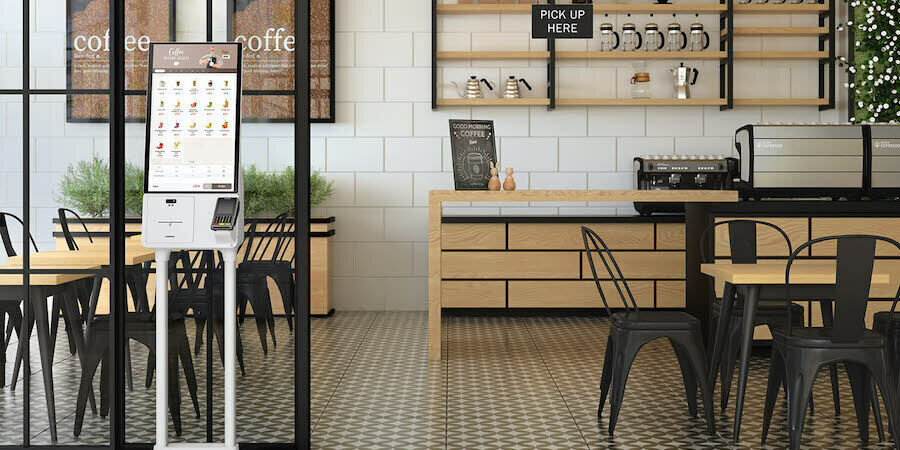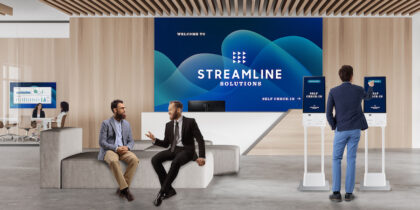The rapid shifts in customer behavior and demands caused by COVID-19 safety protocols forced businesses to adapt almost instantaneously. To keep up, many businesses implemented flexible display technology, such as kiosks.
Self-guided kiosks provide faster, easier shopping transactions, while allowing operators to speed up services, improve order accuracy and deliver positive experiences to drive customer loyalty. Kiosks can even offer customer services, delivering on-demand answers to their pricing or availability questions. Customers have come to expect this kind of convenience from their shopping experiences.
There were already numerous kiosk options on the market, but at Samsung, we saw a gap for an affordable, streamlined, ready-to-go touchscreen unit that could be used for everything — including self-service ordering in burger chains, “endless aisle” product selectors in beauty stores and lobby management in health clinics.
The Samsung Kiosk
Pivotal to the Kiosk’s design process was the idea that smaller businesses should have access to the same interactive screens and transactional technologies used by larger operators. The Samsung Kiosk allows smaller operators to offer those same convenient and speedy shopper experiences in a more intimate, personable setting. Streamlined, flexible and affordable, the Kiosk can work as a single unit in a small shop or as one of many in a large public space.
Enhance the buyer's journey with digital signage
Get your free guide to the what, where and how of digital signage in retail environments. Download Now
The Samsung Kiosk is a 24-inch unit with a highly responsive Projected Capacitive (PCAP) touchscreen, which supports add-ons like:
- Payment pads
- Card readers
- Receipt printers
- QR/barcode scanners
- Optional near-field communication (NFC)
- Wi-Fi
The Kiosk is available in tabletop, floor-standing and wall-mounted variations. The screens are also antimicrobial and shatter-resistant, allowing for heavy public use.
Another big driver of the product design was removing the complication of putting together a kiosk solution. Normally, multiple parties have to come together to specify, design, source and assemble components to get a kiosk up and running.
We had to ask ourselves, “Could we develop an easy-to-deploy solution that would integrate into the entire customer journey? Could we lower the barriers to entry and create something that suited many markets and was easy to deploy across any of them?”
We created a solution that lowers costs, improves lead times and has an attractive, universal design that fits into almost any setting.
Business rationale
A common fallacy is that self-service technology eliminates jobs, but these automated solutions actually allow managers to repurpose staff to other duties. Food services operators, for example, have turned to self-checkout kiosks in order to:
- Speed up transactions, which can increase demand and prompt new kitchen hires
- Improve accuracy of item availability, prices and orders
- Reduce cash handling and end-of-shift counts
- Minimize health safety risks of staff-customer interactions at order counters
Facilitating transactions is the most obvious application for a Samsung Kiosk, but more broadly, an effective kiosk makes it easier for people to get things done in customer-facing industries like retail, hospitality and food services. Kiosks speed up processes, make information readily available to customers and ensure the information is always accurate and up-to-date.
In industries with high staff turnover, such as retail and food services, preloaded up-to-date kiosk content ensures both customers and new or lightly trained staff have access to the answers and options they need, on demand.
They’re also a successful preventative against customers abandoning the checkout line or leaving without completing a transaction, frustrated with the experience.
Interactive experiences have the greatest possible impact, adoption rate and loyal usage when the digital screens align with your business’ established customer journey, rather than simply being dropped into a store. When you understand the full breadth of your customer journey — and are thoughtful about how the new interactive workflow supports that journey — kiosks become powerful tools that customers and employees are happy to use.
Complication removed
The new Samsung Kiosk makes it easy to introduce interactivity to a brick-and-mortar setting. Providers and end users alike enjoy the comfort and reliability of working with a familiar global brand. The futureproofed design allows users to adapt the kiosks to their shifting needs, rather than being forced to buy new gear.
But hardware is just one component in a system that also relies on stable software and an intuitive user experience. We’re currently working with a growing list of software companies that facilitate new features, like hyper-secure self-service ordering and payments. Samsung has the toolsets and experience to fully integrate with sales, inventory and building management systems.
When it comes to interactive technology, the Samsung Kiosk was built to support retailers — and their customers — at every step of the customer journey.
Learn more about how the Samsung Kiosk can streamline and enhance the customer journey in your business. Then, discover new ways you can adapt your store signage to keep shoppers safe and maximize ROI in this free white paper.








